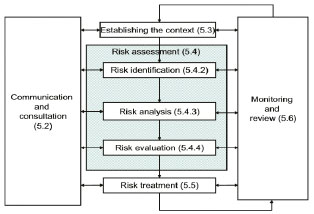Best practice standards, particularly those coming from the International Organization for Standardization (ISO), are being revised or newly created to account for the butterfly effect. ISO is doing this by insertion of “context” clauses into standards such as current ISO 31000:2009 risk management, revisions to ISO 9001 (quality) and ISO 14001 (environmental management) both expected to be final by late 2015, and the newly created ISO 45001 (occupational health and safety management system) with the final standard expected by late 2016.
Context flow
The importance of context is illustrated above in the process flow diagram for ISO 31000:2009, risk management.
Context precedes and is integral throughout the standard’s major clauses. This is a particularly important understanding for occupational safety and health pros, who regularly perform the stages of risk assessment and risk treatment, i.e. control as shown in the diagram.

What is context?
What isn’t context may be a better question. ISO 31000 defines external context (there is internal context to consider as well) to include, but not limited to: social, cultural, political, legal, regulatory, financial, technological, economic, natural and competitive environment, whether international, national, regional, or local; and relationships with, perceptions and values of external stakeholders. This info, however, is just a snapshot of defined context within the standard. In the standard’s full context, think about the butterfly effect.
Numbers
ISO 31000:2009 risk management does not involve certification. Therefore, the number of organizations that conform to the standard and its context clause is difficult to determine. ISO 9001 and ISO 14001, however, are mature standards with certification requirements, and numbers are easier to define. For example, there are currently more than one million ISO 9001 quality certificates world-wide.1
Most of the million+ organizations with ISO quality certificates will seek certification to the ISO 9001:2015 revision when their current certificate expires. The revised quality standard, along with 2015 revisions to ISO 14001, is expected to contain improvements such as inclusion of risk management, management of change, and context.
Health and safety
The first draft of ISO 45001 occupational health and safety management system is available for review.2 Although there are still hurdles to cross, the standard is expected to be final by late 2016. ISO 45001:2016 (?) is a certification standard that will harmonize with other ISO standards. A context clause, therefore, is built into ISO 45001.
Because many CEOs are aware of the ISO quality standard and its local impact and often its necessity to conduct business with other organizations, particularly in the automotive industry, ISO 45001 is expected to more easily be adopted into an organization compared with other occupational health and safety management systems. These other systems include the internationally applied British Standard OHSAS 18001, ANSI/AIHA/ASSE Z10-2012, OSHA VPP, and ILO-OSH: 2001 guidelines. Representatives from each of these other systems have contributed to the development of ISO 45001. Particularly, it is reasonable to expect that nearly all of the approximate 90,000 organizations will migrate to ISO 45001 when their OHSAS 18001 certificates expires.
Context thinking
Context thinking requires organizations to consider not only the effects of what they do, but also the effect on the organization’s objectives by what others do/don’t do.
Frustration with context thinking should be expected. A colleague/friend in the corporate world is often frustrated with my “yes, but” or “no, but” to his questions. He prefers that my answers to questions such as “does the machine need to be guarded or not?” have an absolute answer. The “but” helps me qualify the context under which an answer is given, which should be expected from a consultant who should bring a wide array of views to an issue. ISO auditors will look for documentation from an organization to determine if context to these types of issues are addressed.
Context thinking may encourage people and organizations to question long-held beliefs. Tell an AIHA member, for example, that the industrial hygienist title falls under the U.S. DOL occupational classification as a “health care practitioner.” Then watch the person rationalize this only is applicable for an IH that works in a hospital setting. The real context is far from this thought.
Ask any safety pro to put OSHA’s 2012 HazCom standard risk phrase, “may damage an unborn child,” into ISO context for “relationships with, perceptions and values of external stakeholders.” Few will able to identify who the stakeholders are and what values they hold.
Preparation
To keep pace with context thinking, your first step should be to read the ISO 31000:2009 standard. The information in the standard will prepare you for context clauses found in other ISO standards. The upcoming ISO 45001 standard will be like a large butterfly flapping its wings. In context, be prepared for how the standard will impact your local safety activities.
References
1. http://en.wikipedia.org/wiki/ISO_9000
2. http://www.iso.org/iso/home/news_index/news_archive/news.htm?refid=Ref1874




